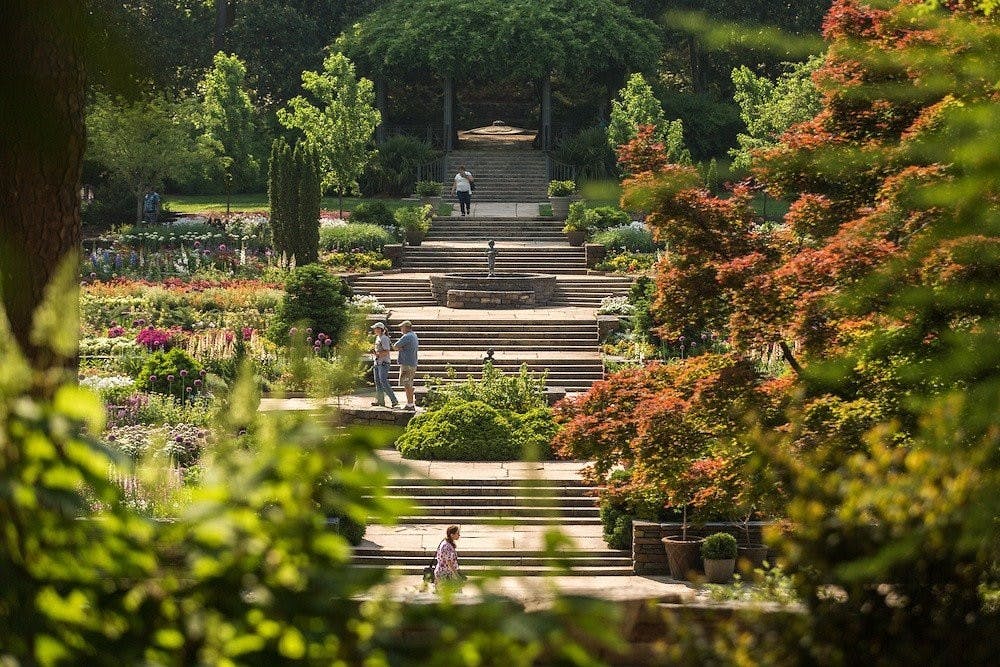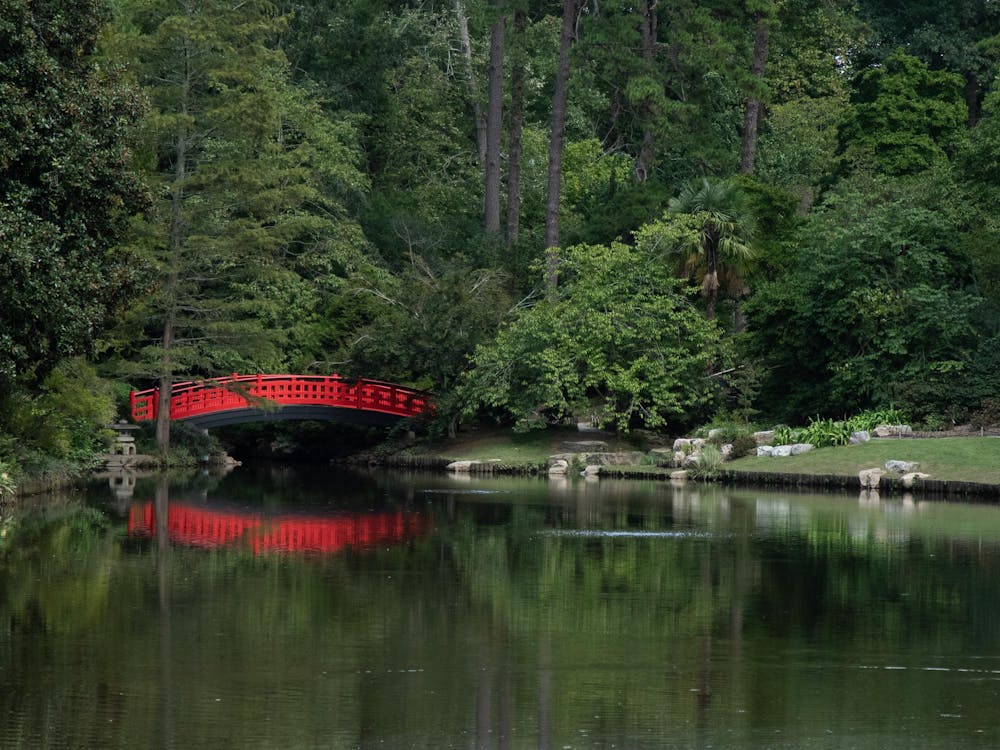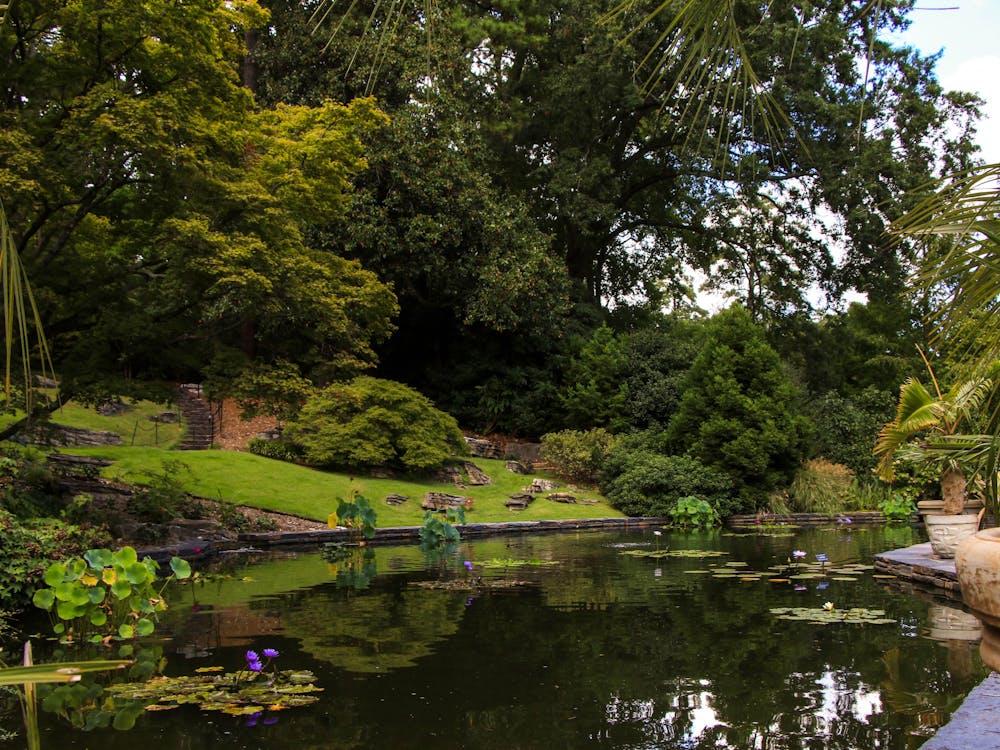In honor of Duke’s Centennial, The Chronicle is highlighting pivotal figures and events throughout the University’s history. Here, we take a look at the founding of the Sarah P. Duke Gardens:
Over 90 years, Sarah P. Duke Gardens has bloomed into one of the University’s most popular attractions.
Yet, such widespread acclaim was not achieved overnight. Since its founding, the gardens have evolved in response to architectural issues and the visions of various supporters.
The 55-acre landmark provides both a unique feature to campus life and a beautiful space for the Durham community. According to its website, over 300,000 people “from all over the world” visit the gardens each year.
While the first flower beds were laid in 1934, the facility was not “formally opened” until 1939, and it has since seen major additions between 1961 and 2021 alongside small improvements over the years.

The beginning of the gardens
Before the 1939 opening ceremony, the gardens had been established for four years and experienced a round of reconstruction. Frederic Hanes, former chairman of the department of medicine, is widely credited with providing the idea for the garden’s current location.
Former Professor of History Robert Durden noted in his book “Duke Gardens through the Years” that Hanes had a “special love for gardening” and sought to improve the appearance of campus in the early 1930s by transforming a “debris-filled” ravine he walked by daily into a garden for irises.
Yet, Hanes’ wishes appeared in neither President William Few’s nor University benefactor James B. Duke’s plans for the space. According to a 1990 copy of the Sarah P. Duke Gardens Flora magazine, Few specifically “liked to point out that Duke University … had been carefully planned in advance.” Blueprints included no mention of a University garden.
Nonetheless, Hanes proceeded with his efforts, inviting John Wister, Philadelphia horticulturist and president of the American Iris Society, to visit Durham and study the proposed site.
Unfortunately for Hanes, 1932 was a year of budget tightening within the University amid the Great Depression, and administrators were skeptical about the expenditure without greater details.
Further investigation by Wister determined that $30,000 would be necessary — half for construction and half for planting — to begin the garden, and additional money would be required for routine maintenance and personnel. The total was ruled infeasible, and Hanes’ proposal failed to find space within the year’s budget.
Again, though, Hanes persisted. In 1934, he persuaded Sarah Duke, widow of Benjamin Duke, to donate $20,000 to the University for a garden bearing her name. She agreed, noting in a May 31 letter that the garden would make a “great attraction” and hold “distinct educational value.”
According to Durden, the project had also received approval by George Allen and William Perkins, both powerful University figures with ties to the Duke Endowment. When combined with Sarah Duke’s contribution, Robert Flowers, then Duke’s vice president for business and secretary-treasurer, and University trustees “promptly endorsed the proposal.”
Construction of the “Sarah P. Duke Garden” began in the summer of 1934, and “more than a hundred flower beds were laid out in … what would later become the South Lawn.”
Wister approximated in a 1934-35 report that 208,000 individual plants, including 50,000 iris and 100,000 daffodils, existed in the gardens at the time. However, much of the University’s efforts in the first year were lost due to heavy summer rains, overflowing of stream banks and a persistent iris rot plague.
Norfleet Webb, first superintendent of the gardens, complained of heavy rain in a report to Wister. He dejectedly noted that the weather caused “a Hell’uva mess.”
Hanes’ decision to start over and rebuild the garden came shortly after the passing of Sarah Duke in 1936. A 1991 edition of the Flora magazine notes that new plans for “a formal garden” were “quite different from the one which existed.”
To finance the reconstruction, Hanes reached out to Mary Duke Biddle, philanthropist and daughter of Sarah Duke. Hanes and Duke Biddle were already close — he supported her while she recovered from a divorce with Anthony Drexel Biddle — and she was happy to provide funding in her mother’s memory.
Get The Chronicle straight to your inbox
Sign up for our weekly newsletter. Cancel at any time.
Construction of the new terrace gardens took place on higher ground in order to better control flooding. The new blueprints, designed by landscape architect Ellen Biddle Shipman, dissatisfied some — like Webb, who preferred the original iris-emphasized garden — but excited many others, including Few.
Before the Duke Gardens, Biddle Shipman had greatly influenced her field. She ran her own landscape design firm at a time when firms did not hire women, and she further opposed convention by only hiring women employees.
The 1991 Flora magazine notes that “women landscape architects obtained few public commissions” at the time. According to landscape architects Judith Tankard and Richard Hartlage, “[Biddle Shipman’s] large and expansive scheme for Duke was unlike anything she had previously been called upon to design.”
The gardens remained closed for much of 1938 before formally reopening in the spring of 1939. The ceremony was among a series of events to celebrate the 100th birthday of Trinity-Duke, with the school’s original predecessor institution of Brown’s Schoolhouse opening in 1838.
On April 21, 1939, the Sarah P. Duke Gardens were officially dedicated. Footage from the event shows many people milling about the terrace gardens, and the crowd would later gather in front of the pergola to hear remarks.
Two more days of ceremony followed the gardens’ dedication, making up the remainder of what was known as the “Duke University Centennial Weekend.”

Growth of the gardens and expansion challenges
In spite of efforts to control water flow within the gardens, flooding issues persisted. As more of the surrounding watershed’s ground surface was paved over, the problem worsened.
According to Larry Daniel, former associate director and superintendent of the gardens, “during really heavy rains, water sometimes would cover the lower terrace.” The terrace sat around 18 inches above the goldfish pond, meaning “fish would wash out” with the rising water levels and be “left flopping around on the South Lawn.”
William Louis Culberson, then-director of the Gardens, finally proposed a solution 43 years after the gardens’ reopening, suggesting the construction of a large earthen dam and a lake at the northern end of the gardens.
By implementing the dam, Culberson fulfilled part of James B. Duke’s vision for the space and provided an end in 1982 to what had been nearly a half-century of struggling to control the excess rainwater.
The newly constructed lake complemented another development soon to come — the William Louis Culberson Asiatic Arboretum. Initiated in 1984 and dedicated in 1998, the roughly 18-acre arboretum includes over 1,300 distinct plant species and cultivars.
Previously, the H.L. Blomquist Garden of Native Plants had been dedicated in 1968, memorializing Blomquist after his death four years prior. According to one visitor guide, it contained “more than 900 species and varieties of regional native plants,” totaling “just over one-tenth of the total number from the regional flora.”
Major construction also occurred between 1961 and 1963, as developments were made to the gardens entrance, parking, South Lawn, greenhouses and offices.
In the fall of 2001, the Doris Duke Center opened as a hub for education programs and other initiatives pertaining to the gardens. The $7 million construction project was the result of a 1996 fundraising campaign and featured a horticultural library, reception hall, gift shop, offices and extensive landscaping.
The center also provided the gardens with its first public indoor space. Speaking with the Duke News Service in 1996, Culberson described the changes as efforts toward becoming “even more friendly” to the landmark’s many visitors.
The Charlotte Brody Discovery Garden is the most recently completed addition to the Duke Gardens portfolio, dedicated and opened in 2012 and meant to serve as a space for teaching about “ideal ecological practices” and the origins of food.
The facility serves as a memorial to Charlotte Brody, an “early and avid organic gardener.” Then-President Richard Brodhead spoke at the garden’s dedication, stating that “every kid whose family comes to Duke Gardens” would be able to discover “the beauty of the natural world.”
A $30 million Garden Gateway Project is currently underway, which will add a new welcome center, indoor and outdoor classroom spaces, cafe and unloading zone for visitors to the space. Construction is slated to begin in fall 2024 and complete in spring 2026.

The vision for the gardens
Many supporters and affiliates of the Duke Gardens have found it to provide a variety of services to community members, but all seem to believe that the space is unique to the University and has become a core element of the Duke identity.
In his book, Durden described a visitor who toured both East and West Campus along with the Gardens before it was dedicated. The visitor later wrote a letter to Few with his thoughts.
“In my opinion the thing that will make Duke University unique and beyond compare in the coming years will be the Duke Gardens,” the letter read.
Recently, a 75th anniversary celebration was held on May 2, 2014. Among event attendees were relatives of the Duke family and alumni chairs from each decade of the Gardens’ existence, including Lib Connor, who graduated in 1939 and was present at the original dedication ceremony.
At the event, Cynthia Brodhead, then-chair of the board of advisers to the Sarah P. Duke Gardens, stated that she wished to rededicate the space for the following 75 years.
“All of the wonderful benevolence that has made this place what it is today, it’s now up to us to carry that forward,” she said.
Ryan Kilgallen is a Trinity sophomore and an associate news editor for the news department.











